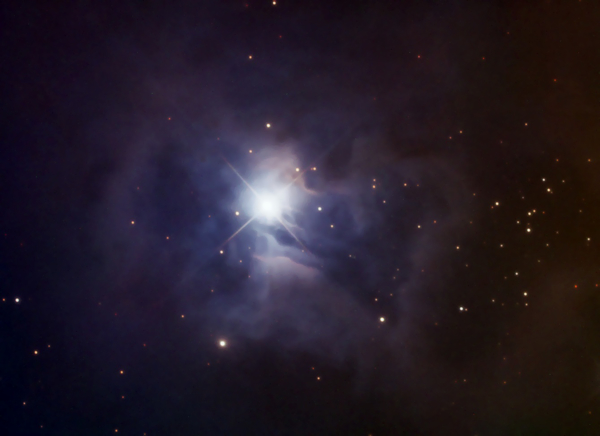NGC 7023 in Cepheus
August 2022 - Nebula and Cluster of the Month
The Milky Way still reigns supreme in the night skies of August, studded with deep-sky gems. This month we’ll be looking at an object that has been at the centre of a whole heap of confusion. Hopefully, by the end of this article, the confusion will be banished.
The object in question is a reflection nebula in Cepheus, NGC 7023. Point of Confusion no. 1 is that it is often listed as an open cluster. In the first edition of Uranometria 2000.0, it is listed as both an open cluster and a bright nebula. The open cluster entry reads Involved in nebulosity which also carries the same designation’ and the bright nebula entry reads ‘Contains open cluster NGC 7023
. No.

First seen by William Herschel on 18 October 1791, he placed it in his fourth class (planetary nebulae – Point of Confusion no. 2) as no. 74. He describes it as A star 7m very much affected with nebulosity, which more than fills the field. It seems to extend to at least a degree all around; smaller stars, such as 9 or 10m of which there are many, are perfectly free from this appearance.
Firstly, although NGC 7023 is not a planetary nebula by our modern definitions, there was no scientific definition of planetary nebulae per se at this time. In fact, it was Herschel himself who coined the phrase ‘planetary nebula’, to describe the visual appearance of certain objects that he saw. It was only in the following century that the term was applied exclusively in the way we do now.
Herschel’s description of many ninth and tenth magnitude stars may have led to the belief that he was describing an open cluster. However, he is only describing the rich field seen at lower powers and is using the presence of these other non-nebulous stars to highlight the nebulous appearance of the main star (now called V380 Cep, an Orion-type variable of early spectral type – B3 in this case – with a magnitude range of about 7.2 to 7.4).
Point of Confusion no. 3 is that there is an open cluster here. It was listed by the Swedish astronomer Per Collinder as Cr 427. It is a small, loose cluster centred about 5’ to the west of V380 Cep. Its brightest member star is magnitude 15.6, so it’s unlikely to trouble most visual observers. It is expressly not catalogued as NGC 7023.
Point of Confusion no. 4 is that Collinder mistakenly listed this cluster twice. The second entry, Cr 429, was incorrectly equated by him with NGC 7023. Furthermore, (Point of Confusion no. 5) both the entries in his catalogue are positioned slightly too far to the west, putting Cr 429 in an utterly blank region 6’ west of Cr 427.
In his Atlas of Open Star Clusters (Volume 2 in the earlier edition), Mike Swann correctly positions Cr 427 within the nebulosity of NGC 7023.
These compounded errors have been duplicated in many catalogues, and are repeated ad nauseam across the internet. The real facts are that NGC 7023 is a reflection nebula centred on the seventh magnitude star V380 Cephei. 5’ to the west of V380 is a very faint open cluster Cr 427. NGC 7023 is not, and never was, the designation of an open cluster. Cr 429 does not exist as a separate object but is a slightly misplaced relisting of Cr 427.

Visually speaking, NGC 7023 is a quite striking object. The central star is surrounded by a circular disc of bright nebulosity and there are fainter nebulous fans stretching out east and west. The fan to the west is the brighter and contains much barely-glimpsed obscuration. The one feature that could be clearly seen and held is a straight line of dark material southwest of the bright central star. This is a prominent feature in images of the nebula. The fan of nebulosity to the east of the central star is fainter, and no certain dark features could be discerned. I found the use of a UHC filter helped considerably with this object.
Herschel’s description of the nebulosity spreading ‘at least a degree’ is an exaggeration. My observation shows the longest dimension to the nebulosity of about 7’. Images can double this, but the outer nebulosity is very faint.
| Object | RA | Dec | Type | Magnitude |
|---|---|---|---|---|
| NGC 7023 | 21h 01’ 37” | +68° 09’ 55” | Reflection nebula | 7 |
| Cr 427 = Cr 429 | 21h 00’ 36” | +68° 09’ 46” | Open Cluster | Br* = 15.6 |